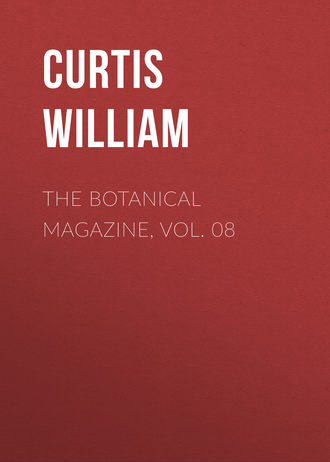 полная версия
полная версияThe Botanical Magazine, Vol. 08

William Curtis
The Botanical Magazine Vol. 08 / Or, Flower-Garden Displayed
[253]
Lathyrus Articulatus. Jointed-Podded Lathyrus
Class and OrderDiadelphia DecandriaGeneric CharacterStylus planus, supra villosus, superne latior. Cal. laciniæ superiores 2-breviores.
Specific Character and SynonymsLATHYRUS articulatus pedunculis subunifloris, cirrhis polyphyllis; foliolis alternis. Linn. Syst. Veg. ed. 14. Murr. p. 662. Ait. Kew. v. 2. p. 41.
CLYMENUM hispanicum, flore vario, siliqua articulata. Tourn. Inst. 396.
LATHYRUS hispanicus, pedunculis bifloris, cirrhis polyphyllis foliolis alternis. Mill. Dict. ed. 6. 4to.
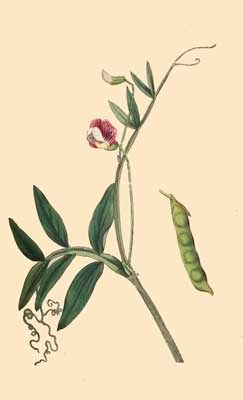
No253.
The seed-vessels are of the first importance in ascertaining the several species of Lathyrus, some being naked, others hairy, some long, others short, some having a smooth and perfectly even surface, others, as in the present instance, assuming an uneven or jointed appearance.
Of this genus we have already figured three annual species, common in flower-gardens, viz. odoratus, tingitanus, and sativus; to these we now add the articulatus, not altogether so frequently met with, but meriting a place on the flower-border, as the lively red and delicate white so conspicuous in its blossoms, causes it to be much admired.
It is a native of Italy, and was cultivated at the Chelsea Garden, in the time of Mr. Rand, anno 1739.
It is a hardy annual, requiring support, and rarely exceeding the height of two feet, flowering in July and August, and is readily raised from seeds, which should be sown in the open border at the beginning of April.
[254]
Lopezia Racemosa. Mexican Lopezia
Cal. 4-phyllus. Cor. irregularis, pentapetala, duo superiora geniculata, quintum inferne declinatum, plicatum, ungue arcuata.
Specific Character and SynonymsLOPEZIA racemosa caule herbaceo ramoso; foliis alternis ovato-lanceolatis, serratis; floribus racemosis. Cavanilles Ic. et descr. Pl.
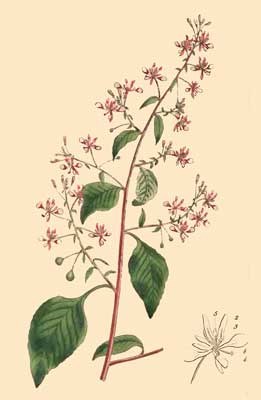
No254.
Some plants have a claim on our attention for their utility, some for their beauty, and some for the singularity of their structure, and the wonderful nature of their œconomy; in the last class we must place the present plant, the flowers of which we recommend to the examination of such of our readers as may have an opportunity of seeing them; to the philosophic mind, not captivated with mere shew, they will afford a most delicious treat.
We first saw this novelty in flower, towards the close of the year 1792, at the Apothecaries Garden, Chelsea, where Mr. Fairbairn informed me, that he had that season raised several plants of it from seeds, communicated by Dr. J. E. Smith, who received them from Madrid, to which place they were sent from South-America, and where the plant as Mons. Cavanille informs us, grows spontaneously near Mexico. In October 1793, we had the pleasure of seeing the plant again in blossom in the aforesaid garden, raised from seeds which ripened there the preceding year, but unfortunately from the lateness of their flowering, and the very great injury the plants had sustained from the Cobweb Mite (Acarus teliarius) vulgarly called the red Spider, there seemed little prospect that the seed-vessels would arrive at perfection.
The seeds were sown by Mr. Fairbairn, in March, and the plants kept in the green-house till very late in the summer, when to accelerate their blowing, they were removed into the dry stove: it is worthy of remark, that these plants, even late in the autumn, shew no signs of blossoming, but the flowers at length come forth with almost unexampled rapidity, and the seed-vessels are formed as quickly, so that if the flowers were not very numerous, their blossoming period would be of very short duration; future experience may perhaps point out the means of making the plant blow earlier: in Spain, the blossoms appeared later than here, Mons. Cavanille observed them in the Royal Garden, in November and December, most probably in the open ground, as no mention is made of the plants having been preserved from the weather.
It was not till long after our description was taken, that we had an opportunity of seeing Mons. Cavanille's most accurate and elegant work, above quoted, in which this plant is first figured and described; we have selected the most essential parts of his generic character, and adopted his specific description: there is one point, however, in which we differ from him; the part which he regards as the fifth Petal, we are inclined to consider rather as that indescribable something, called by Linnæus the Nectary, it is indeed of little moment whether we call it a Petal or a Nectary, but there are several reasons why, strictly speaking, we cannot regard it as a Petal: in general the number of Petals correspond with the number of the leaves of the Calyx, those of the latter are four; the base of this Nectary originates deeper than the claws of the Petals, springing in fact from the same part as the Filament, its structure, especially the lower part of it, is evidently different from that of the Petals, corresponding indeed as nearly as possible with that of the base of the filament.—Vid. Descer.
Mons. Cavanille was induced to call this plant Lopezia, in compliment to Th. Lopez, a Spaniard1.
DESCRIPTION OF THE LOPEZIA
ROOT annual.
STALK five or six feet high, branched almost to the bottom, square, of a deep red colour, smooth towards the bottom, slightly hairy above: Branches like the stalk.
LEAVES alternate, ovate, pointed, toothed on the edges, more so on the larger leaves, slightly beset with soft hairs, veins prominent on the under side, usually running parallel to each other and unbranched: Leafstalks hairy.
FLOWERS numerous, from the alæ of the leaves, growing irregularly on hairy leafy racemi, standing on long slender peduncles, which hang down as the seed-vessels are produced: in this and some others of its characters, the plant shews some affinity to the Circæa.
CALYX: a Perianthium of four leaves, sitting on the Germen, leaves narrow, concave, reddish, with green tips, the lowermost one widely separated from the others, and placed immediately under the Nectary, fig. 1.
COROLLA four Petals of a pale red colour, forming in their mode of growth the upper half of a circle, the two uppermost linear, of a deeper colour near the apex, jointed below the middle, with a small green gland on each joint, standing on short round footstalks, which are hairy when magnified, the two side Petals nearly orbicular with long narrow claws, the part between the base of the Petal and the claw of a deeper red or crimson, fig. 2.
NECTARY situated below the Petals, perfectly white, somewhat ovate, the sides folding together, before the flower fully expands, nearly upright, embracing and containing within it the Pistillum and Stamen, on touching it ever so slightly with the point of a pin, while in this state, it suddenly springs back and quits the Pistillum, the lower elastic part of it is then bent in the form represented in a magnified view of the flower on the plate, fig. 4. this curious phœnomenon has not been noticed by Cavanille.
STAMEN: Filament one, tapering and very slender just below the Anthera, arising from the same part as (and placed opposite to the base of) the Nectary the lower part of it broader, somewhat fleshy, cartilaginous, and of the same nature as the inferior part of the Nectary, with a groove as that has on the inside, so that before the flower expands, the bases of each are like two half tubes, the sides of which, nearly touching each other, wholly enclose the Pistillum; as the fructification goes forward, the Filament, endowed also with an elastic power, bends back soon after the flower is open, betwixt the two uppermost Petals, and becomes invisible to an inattentive observer; the Anthera, which is large, is at first yellow, and afterwards dark brown, fig. 5.
PISTILLUM: Germen below the Calyx, round, smooth, and green; Style filiform, white, length of the Filament; Stigma forming a small villous head, fig. 6. in some of the flowers the Pistillum appears imperfect, being much shorter than usual, and wanting the Stigma, perhaps such have not acquired their full growth, fig. 6.
PERICARPIUM (from Cavanille) a round Capsule, of four cells, and four valves, the cells many-seeded.
SEEDS very minute, ovate, affixed to a four-cornered receptacle.
[255]
Cytisus Sessilifolius. Sessile-Leav'd, or Common Cytisus
Class and OrderDiadelphia DecandriaGeneric CharacterCal. 2-labiatus: 2/3 Legumen basi attenuatum.
Specific Character and SynonymsCYTISUS sessilifolius racemis erectis, calycibus bractæa triplici, foliis floralibus sessilibus. Linn. Syst. Vegetab. ed. 14. Murr. p. 666. Ait. Kew. v. 2. p. 50.
CYTISUS glabris foliis subrotundis, pediculis brevissimis. Bauh. Pin. p. 390.
CYTISUS vulgatior, the common Tree Trefoile. Park. Parad. p. 440.

No255.
The term sessilifolius has been given to this species of Cytisus, because the leaves are for the most part sessile, that is sit close to the branches, without any or very short footstalks; such they are at least on the flowering branches when the shrub is in blossom, but at the close of the summer they are no longer so, the leaves acquiring very evident footstalks.
It is a native of the more southern parts of Europe, and though in point of size and elegance it cannot vie with its kindred Laburnum, it is a deciduous shrub of considerable beauty, rarely exceeding the height of five or six feet, and producing a great profusion of bright yellow flowers, which continue in blossom a long while; they make their appearance in May and June, and are usually succeeded by seed-vessels which produce ripe seeds, by these the plant is readily propagated.
It is one of the most common shrubs we have, as well as one of the oldest inhabitants of our shrubberies, being mentioned by Parkinson in his Parad. Terrestris.
[256]
Ixia Longiflora. Long-Flower'd Ixia
Class and OrderTriandria MonogyniaGeneric CharacterCor. 6-partita, campanulata, regularis. Stigmata 3.
Specific Character and SynonymsIXIA longiflora foliis ensiformibus linearibus strictis, tubo filiformi longissimo. Ait. Kew. v. 4. p. 58.
GLADIOLUS longiflorus caule tereti, tubo longissimo, spathis foliisque linearibus glabris. Linn. Suppl. p. 96. Gmel. Syst. Vegetab. ed. 14. Murr. p. 86.
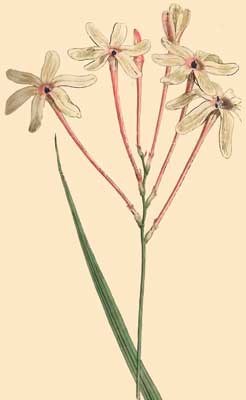
No256.
We are not acquainted with a tribe of plants which stand more in need of elucidation than those of this genus; of the vast numbers imported from the Cape within these few years, where they are chiefly natives, and that for the most part by way of Holland, few comparatively are well ascertained; some of them appear subject to great variation, both in the size and colour of their blossoms (whether in their wild state they are thus inconstant, or whether there are seminal varieties raised by the persevering industry of the Dutch Florists, we have not yet had it in our power satisfactorily to ascertain); others like the present one have their characters strongly marked, and less variable; in general they are plants of easy culture, requiring chiefly to be protected from the effects of frost, the least degree of which is presently fatal to most of them.
The treatment recommended for the Ixia flexuosa is applicable to this and the other Cape species.
According to the Hort. Kew. this species was introduced by Mr. Masson in the year 1774.
It flowers from April to June.
[257]
Lychnis Chalcedonica. Scarlet Lychnis
Class and OrderDecandria PentagyniaGeneric CharacterCal. 1-phyllus, oblongus, lævis. Petala 5-unguiculata. Limbo sub-bifido. Caps. 5-locularis.
Specific Character and SynonymsLYCHNIS chalcedonica floribus fasciculatis fastigiatis. Linn. Syst. Vegetab. ed. 14. Murr. p. 435. Ait. Kew. v. 2. p. 16.
LYCHNIS hirsuta flore coccineo major. Bauh. Pin. 203.
FLOS Constantinopolitanus. Dod. Pempt. 178.
LYCHNIS chalcedonica flore simplici miniato. Single Nonsuch, or Flower of Bristow or Constantinople. Parkins. Parad. 253.
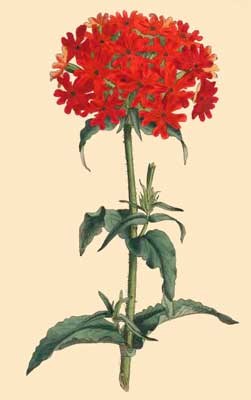
No257.
The Scarlet Lychnis appears to have been a great favourite with Parkinson, he calls it a glorious flower, and in a wooden print of him prefixed to his Paradisus Terrestris, we see him represented with a flower of this sort in his hand of the double kind.
It grows spontaneously in most parts of Russia, and is one of our most hardy perennials.
The extreme brilliancy of its flowers renders it a plant, in its single state highly ornamental; when double, its beauty is heightened, and the duration of it increased.
It flowers in June and July.
The single sort may be increased by parting its roots in autumn, but more abundantly by seeds, which should be sown in the spring; the double sort may also be increased by dividing its roots, but more plentifully by cuttings of the stalk, put in in June, before the flowers make their appearance; in striking of these, however, there requires some nicety.
This plant is found to succeed best in a rich, loamy, soil; and certain districts have been found to be more favourable to its growth than others.
A white and a pale red variety of it in its single state were known to Clusius, and similar varieties of the double kind are said to exist; it is of little moment whether they do or not, every variation in this plant from a bright scarlet is in every sense of the word a degeneracy.
[258]
Coronilla Varia. Purple Coronilla
Class and OrderDiadelphia DecandriaGeneric CharacterCal. 2-labiatus: 2/3: dentibus superioribus connatis. Vexillum vix alis longius. Legumen isthmis interceptum.
Specific Character and SynonymsCORONILLA varia herbacea, leguminibus erectis teretibus torosis numerosis, foliolis plurimis glabris. Linn. Syst. Vegetab. ed. 14. Murr. p. 670. Ait. Kew. v. 3. p. 59.
SECURIDACA dumetorum major, flore vario, siliquis articulatis. Bauh. Pin. p. 349.
SECURIDACA II. altera species. Clus. Hist. 2. ccxxxvij. The greater joynted Hatchet Vetch. Park. Theat. p. 1088.
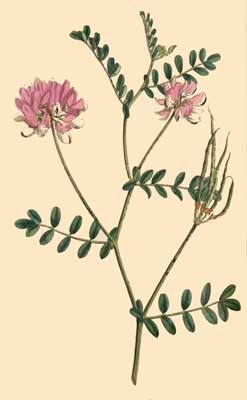
No258.
Clusius, in his work above referred to, informs us that he found this plant growing wild in various parts of Germany, in meadows, fields, and by road sides; that it flowered in June, sometimes the whole summer through, and ripened its seeds in July and August; the blossoms he found subject to much variation of colour, being either deep purple, whitish, or even wholly white: Casp. Bauhine notices another variety, in which the alæ are white and the rostrum purple; this variety, which we have had the honour to receive from the Earl of Egremont is the most desirable one to cultivate in gardens, as it is more ornamental than the one wholly purple, most commonly met with in the nurseries, and corresponds also better with its name of varia; it is to be noted however that this variety of colour exists only in the young blossoms.
The Coronilla varia is a hardy, perennial, herbaceous plant, climbing, if supported, to the height of four or five feet, otherwise spreading widely on the ground, and frequently injuring less robust plants growing near it; on this account, as well as from its having powerfully creeping roots whereby it greatly increases, though a pretty plant, and flowering during most of the summer, it is not to be introduced without caution, and is rather to be placed in the shrubbery, or outskirts of the garden, than in the flower border.
It will grow in any soil or situation, but blossoms and seeds most freely in a soil moderately dry.
Parkinson in his Theater of Plants, mentions its being cultivated, as an ornamental plant. Ait. Kew.
Its bitterness, will be an objection to its being cultivated for the use of cattle, for which purpose it has been recommended.
[259]
Lilium Catesbæi. Catesby's Lily
Class and OrderHexandria MonogyniaGeneric CharacterCor. 6-petala campanulata: linea longitudinali nectarifera. Caps. valvulis pilo cancellato connexis.
Specific Character and SynonymsLILIUM Catesbæi caule unifloro, petalis erectis unguiculatis. Linn. Syst. Nat. ed. 13. Gmel. p. 545.
LILIUM Catesbæi foliis sparsis, bipedali, flore unico erecto, corolla campanulata, petalis unguibus angustis longis. Walt. Fl. Carol. p. 123.
LILIUM Spectabile foliis sparsis; floribus solitariis erectis; petalorum unguibus angustis, alternis extus utrinque sulcatis, laminis revolutis. Salisb. Ic. Stirp. rar. t. 5.

No259.
At the close of the year 1787, Mr. Robert Squibb, sent me from South-Carolina roots of the Lily here figured, many of which have since flowered with various persons in this kingdom.
Catesby in his Natural History of Carolina, gives a figure and short account of it; Walter in his Flora Caroliniana describes it under the name of Lilium Catesbæi; Mr. Salisbury in the first number of his very magnificent work, lately published, presents us with a very highly finished likeness of this lily, accompanied by a most accurate and minute description of it, and judging from some appearances in Catesby's figure, that it was not the Lilium Catesbæi of Walter, names it spectabile; but as we are assured by Mr. Squibb, who assisted his friend Walter in his publication, that it was the lily figured by Catesby, we have continued the name given in honour of that Naturalist.
Of the different Lilies cultivated in this country, this is to be numbered among the least, the whole plant when in bloom being frequently little more than a foot high; in its native soil it is described as growing to the height of two feet; the stalk is terminated by one upright flower, of the form and colour represented on the plate; we have observed it to vary considerably in the breadth of its petals, in their colour, and spots.
It flowers usually in July and August.
This plant may be raised from seeds, or increased by offsets, which, however, are not very plentifully produced, nor is the plant to be made grow in perfection without great care, the roots in particular are to be guarded against frost; the soil and situation may be the same as recommended for the Cyclamen Coum. p. 4. v. 1.
[260]
Metrosideros Citrina. Harsh-Leav'd Metrosideros
Class and OrderIcosandria MonogyniaGeneric CharacterCal. 5-dentatus, sinu germen fovens. Petala 5, caduca. Stam. discreta, petalis multoties longiora. Caps. 3-4 locularis, polysperma. Banks. Gærtner.
Specific Character and SynonymsMETROSIDEROS citrina foliis lineari-lanceolatis rigentibus.
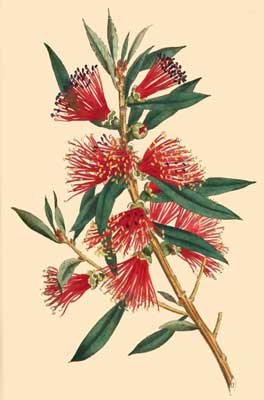
No260.
Though many species of this genus have been raised from seeds, brought within these few years from the South Seas, where they are said to be very numerous; this is, we believe, the only one that as yet has flowered in this country: our drawing was made from a plant which blossomed toward the close of last summer at Lord Cremornes, the root of which had been sent from Botany-Bay; previous to this period we have been informed, that the same species flowered both at Kew and Sion-House: as it is without difficulty raised both from seeds and cuttings, young plants of it are to be seen in most of the Nurseries near town; it would seem that they do not flower till they are at least five or six years old.
Metrosideros is a name given originally by Rumphius in Herb. Amboin to some plants of this genus, the term applies to the hardness of their wood, which by the Dutch is called Yzerhout (Ironwood): Forster in his Gen. Pl. figures this and another genus on the same plate, under the name of Leptospermum; Schreber in his edition of the Gen. Pl. of Linnæus, unites Metrosideros, Melaleuca, Leptospermum, and Fabricia, under the genus Melaleuca; Gærtner in his elaborate work on the seeds of plants, makes separate genera of these, agreeably to the ideas of Sir Joseph Banks and Mr. Dryander, who on this subject can certainly boast the best information.
We cannot, without transgressing the allotted limits of our letter-press, give a minute description of the plant figured; suffice it to say, that it is an ever-green shrub, growing to the height of from four to six or more feet, that its leaves on the old wood feel very harsh or rigid to the touch, and when bruised give forth an agreeable fragrance, the flowers grow in spikes on the tops of the branches, and owe their beauty wholly to the brilliant colour of the filaments.
[261]
Erodium Incarnatum. Flesh-Coloured Crane's-Bill
Class and OrderMonadelphia PentandriaGeneric CharacterCal. 5-phyllus. Cor. 5-petala. Nect. Squamulæ 5 cum filamentis alternantes; et glandulæ melliferæ, basi staminum insidentes. Fructus 5-coccus, rostratus; rostra spiralia, introrsum barbata. L'Herit. Geran.
Specific Character and SynonymsERODIUM incarnatum pedunculis paucifloris, foliis tripartitis ternatisve trifidis scabris, caule fruticuloso. L'Herit. n. 21. tab. 5. Ait. Kew. v. 2. p. 415.
GERANIUM incarnatum pedunculis bifloris, foliis tripartitis trifidis glabris, petalis integris, arillis glabris. Linn. Suppl. Pl.
GERANIUM incarnatum foliis incisis quinquelobis punctatis; petiolis longissimis, pedunculis trifloris. Cavanill. diff. 4. p. 223. n. 314. t. 97. f. 3.
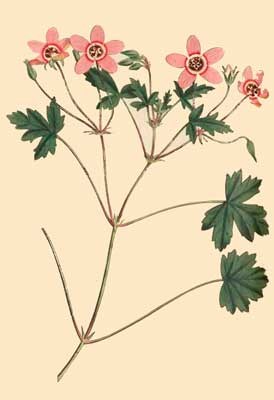
No261.
In the 80th number of this work we gave a figure of the Pelargonium tricolor, a plant very generally regarded as the most beautiful of the genus; we now present our readers with the representation of an Erodium, which has to boast nearly an equal share of admiration.
This species, as we learn from the Hortus Kewensis, is a native of the Cape, and was introduced by Mr. Masson in the year 1787.




